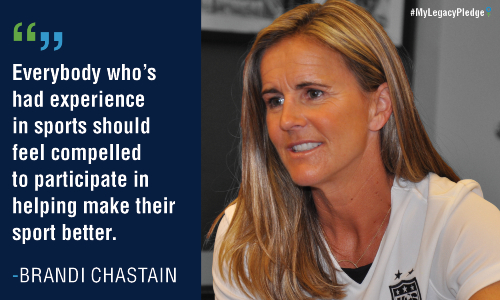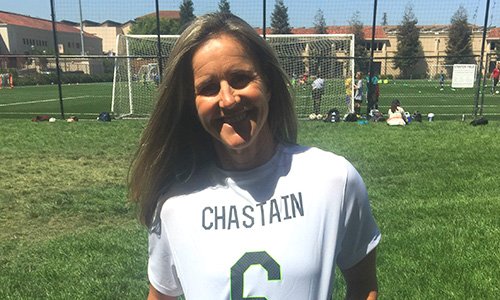The My Legacy campaign was launched to recognize individuals who have made a lasting contribution to research and awareness of concussions and CTE, and encourages others to pitch in and create their own legacy.
When it comes to legacies, few athletes have been more impactful than Brandi Chastain. Her penalty kick past China’s Gao Hong in 1999 sealed the United States’ World Cup victory, and her celebration – pulling off her jersey, sliding to her knees with two fists raised in jubilation – launched women’s soccer into a new stratosphere. The moment was watched on television by 40 million people, immortalized on the covers of Newsweek, Time, People and Sports Illustrated, and has been widely called the greatest moment in U.S. women’s sports history.

Posted: March 3, 2016
Hundreds of thousands of youth, high school and college soccer careers were inspired by Chastain’s left-footed boot in 1999. A soccer lifer, she continues to be involved with and give back to the sport. Chastain is a Volunteer Assistant Coach at her alma mater, Santa Clara University, and is a vocal advocate for Safer Soccer, the campaign that encourages delaying the introduction of headers in youth soccer until high school.
The soccer icon isn’t stopping there, however. Chastain has pledged her brain to the Concussion Legacy Foundation as part of My Legacy. During an age in which we’re seeing an ever-increasing need to prevent, manage and treat concussions and brain damage from soccer, one of the sport’s biggest legends is giving all she can to help make the sport safer for future generations.
Why are you donating your brain to the Concussion Legacy Foundation?
With more information, the greater public can make better choices. I won’t be witness to the results when I donate my brain, and I hope that day is a long way from today, but I’m hoping that my donation helps change things for the positive. I hope my experience in soccer and what I am able to give back helps put soccer in a better place than it was when I started.
Having played soccer since I was little, I can’t even attempt a guess at how many times I’ve headed the ball. It’s a significant number. It’s scary to think about all the heading and potential concussions that were never diagnosed in my life, but it’s better to know.

How do you envision this research being used and making a difference for future generations?
Making a pledge like this, ultimately I’m thinking about the players. How do we evaluate what happened in my brain – when I started doing things like repetitive heading – and then take those results to improve the way we coach our young players? Can what we learn help change rules even more? Maybe by the time they study my brain, we’ll have other testing for things that aren’t even in our vision at this time. To move forward, you have to examine what’s happened in the past and see how we can change things for the future.
What do you want your legacy to be?
My experiences through sports have all been amazing, and I’m so grateful that I lived in a community that supported me participating. Because of my experiences, I have an opportunity to influence other coaches, players, and parents. Through working with Chris Nowinski and Dr. Robert Cantu I’ve learned a lot about the health and wellness of our athletes in a way that I never thought about before. We’ve asked questions that no one ever posed before. Because of these conversations and these interactions, as a parent I see my legacy changing from a soccer player to an athlete ambassador. I want to protect my kids – and it’s not just my kids, but every kid who steps onto the soccer field. I want to protect them and make sure that they get to have the kinds of experiences I had through soccer, while being safer and cared for.
You’ve been very involved with the Safer Soccer campaign to eliminate heading for kids under 14. That campaign saw a victory in November, with U.S. Soccer announcing its new rule prohibiting heading for players under 11 and limiting headers for players aged 11 to 13. What was your reaction to that news?
It’s a positive step that there’s been an amendment on the age, but there’s still a long way to go to provide a safer soccer environment for our kids, and for all of our players. We’d love U.S. Soccer to stand up and say, ’11 is still too young. Let’s protect these kids even longer.’ And what we’re pushing for doesn’t just apply here in the U.S., it’s really on a global scale. Soccer has a great influence on the world, and it has the opportunity to stand up and make a statement that as a unifying organization it wants to really make a difference in the lives of people, especially the youngest and most vulnerable people playing its sport.
Is donating one’s brain to research something that you’d like to see catch on among other former athletes?
This is such a personal issue, but what I would encourage is that everybody who’s had experience in sports should feel compelled to participate in helping make their sport better. If you have been a player who’s had multiple concussions or repetitive heading, to me it makes sense to donate and to be a part of a solution.
For so long, players with concussions have in many ways had to be in the dark on their own, dealing with symptoms, diminished capacity, or eventually experiencing the pain of having to step away from their sport. When you feel vulnerable and you feel like there are no answers, you feel alone. This is a chance to be empowered. By knowing that we’re not alone, and by working together and getting more people to follow suit, maybe in the future, we have less reason to worry about concussions. Ultimately, that’s where we want to get to. We’d like to be out of the job of talking about this.
RELATED: Pledge your brain to research
Below is a full transcription of Brandi’s interview:
WHO IS BRANDI CHASTAIN?
My name is Brandi Chastain. I’ve been in three World Cups and three Olympic Games.
ON THE CULTURE CHANGE IN SOCCER:
When I was with the national team as a player we talked about the legacy that we would leave and what we were doing on the field and how it would impact the game. Initially, it was about playing hard and being a team and, you know, setting goals and learning leadership skills and all the things that you need in life to be successful. But no one ever talked about being safe.
ON WHETHER KIDS SHOULD BE HEADING:
I don’t think anybody below the age of 14 should head the ball. Being more knowledgeable about what can happen to a small person whose musculature is not developed enough, and their brain is not developed enough, they don’t have enough life experience. They don’t understand space and time and awareness. These things that really allow a professional player to make good decisions and to protect themselves that these young kids don’t they just don’t possess these tools yet. Every sport has a chance to evolve. I think this is a part of our evolution.
ON SAFER SOCCER AS HER LEGACY:
Safer Soccer is the legacy that I’m hoping to leave for the long haul, for the future of this game, where we’ll have more people who will start the game as youngsters and play the game longer because they’ll be safe.
